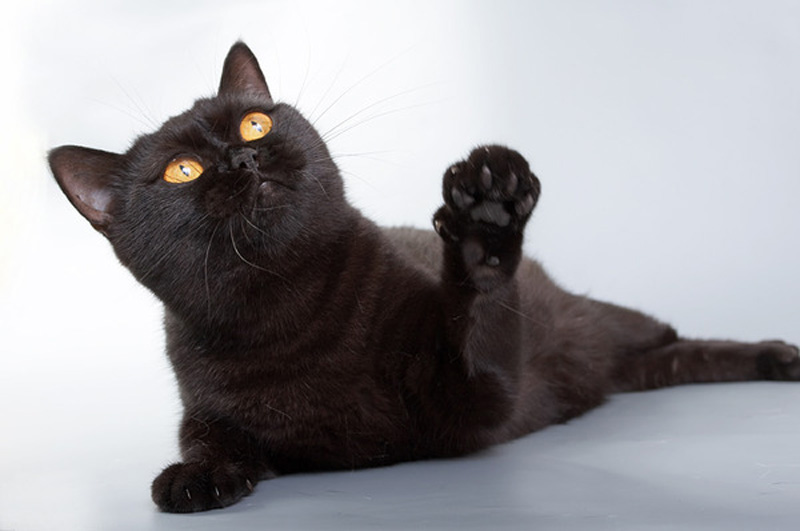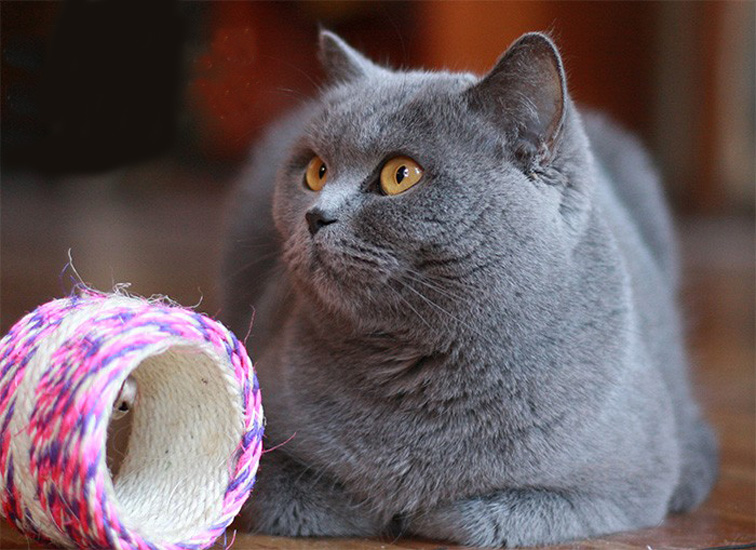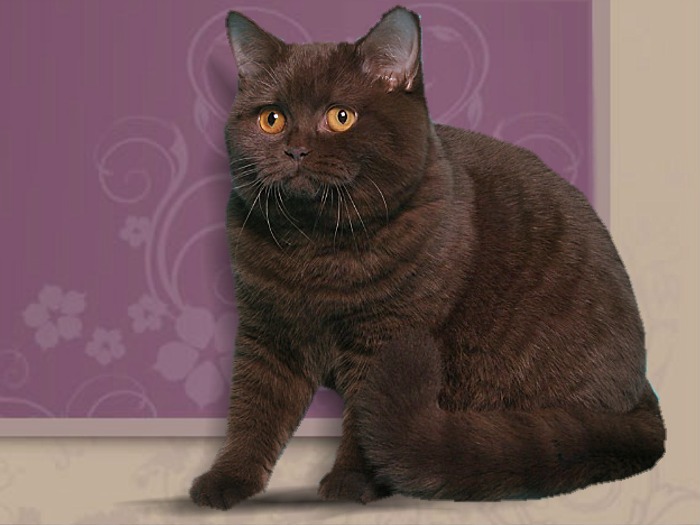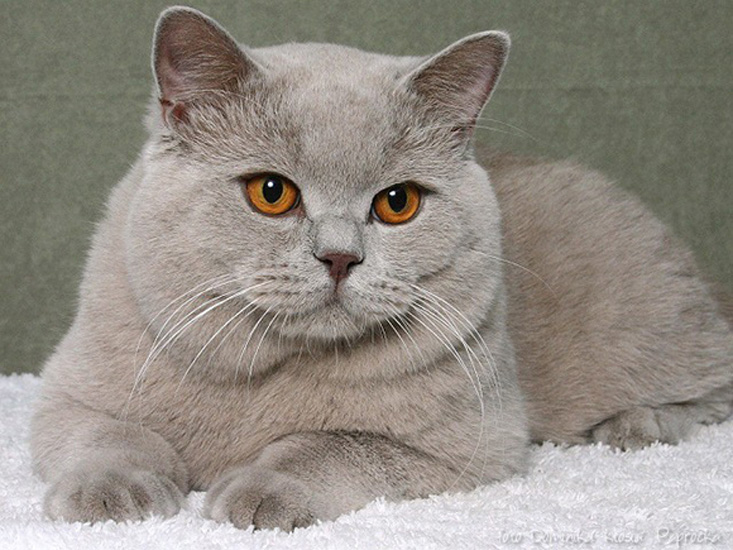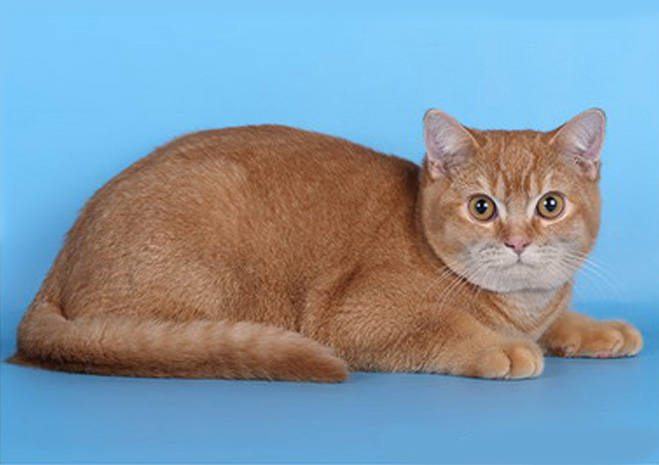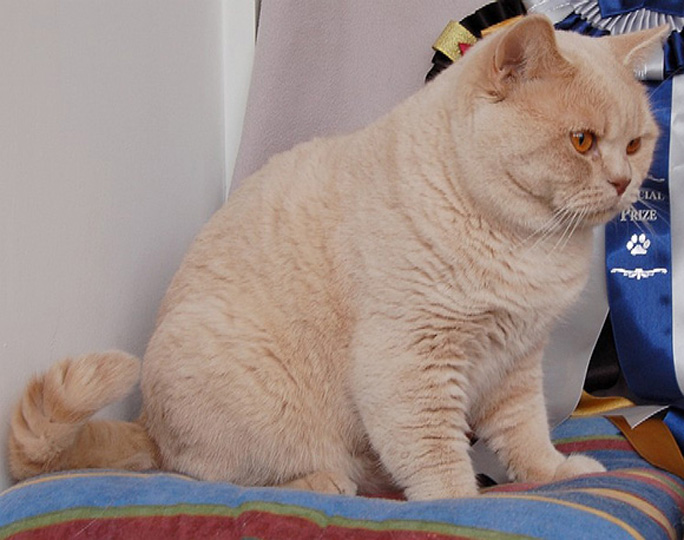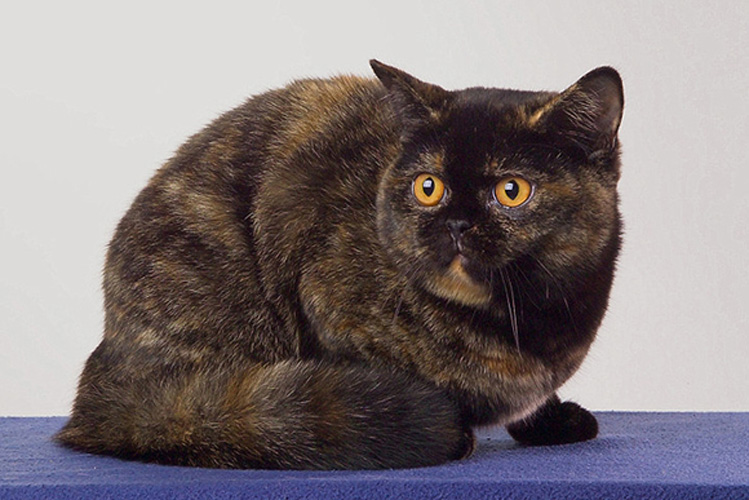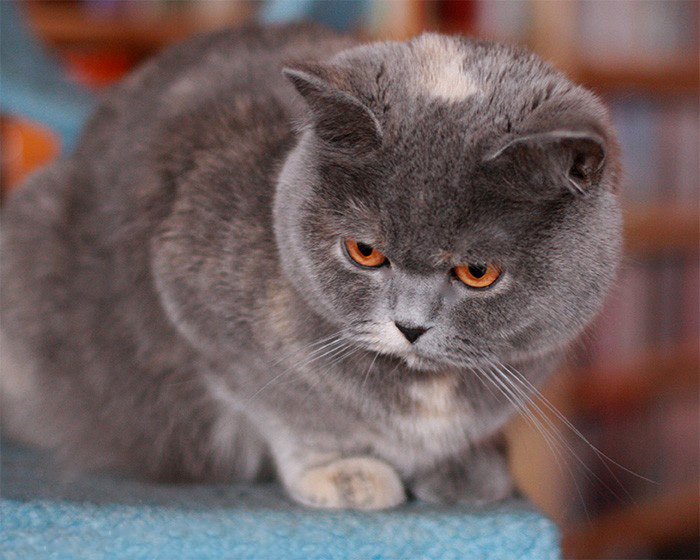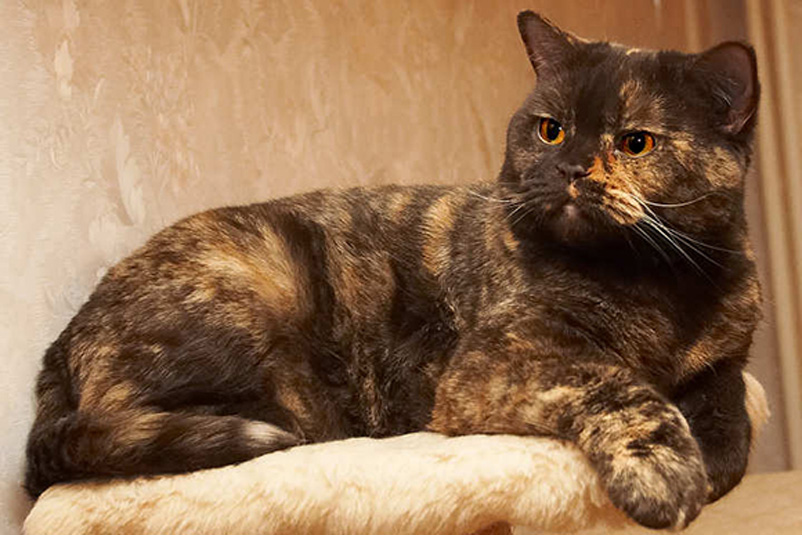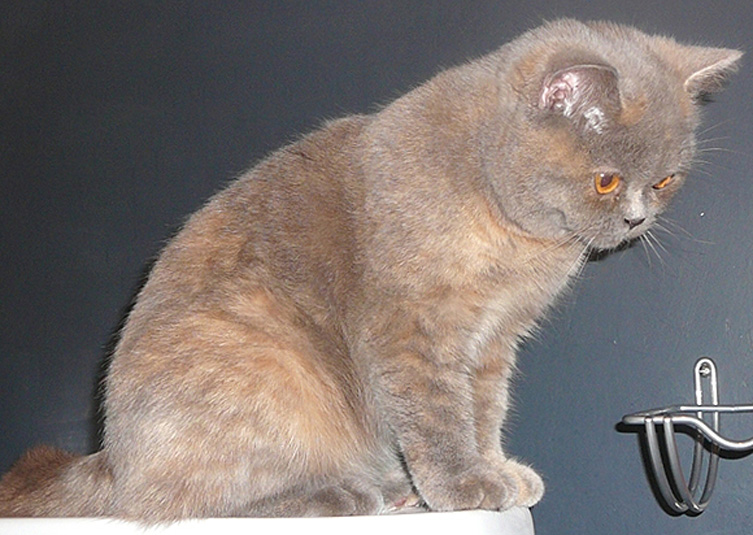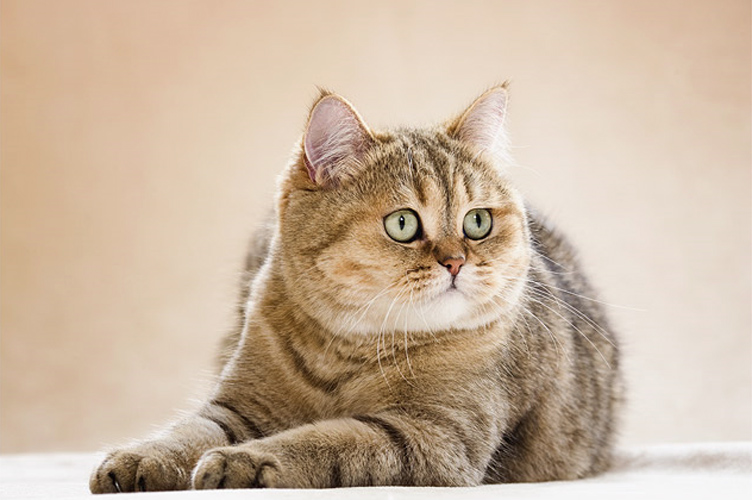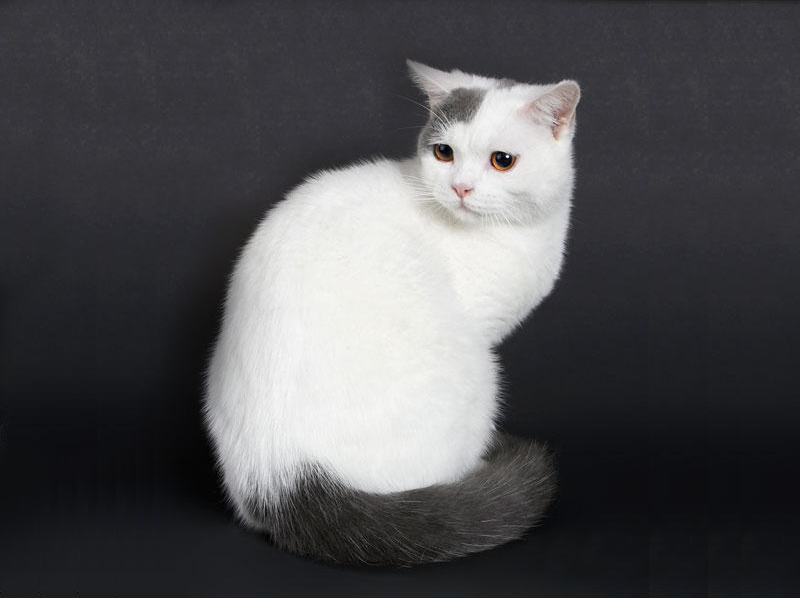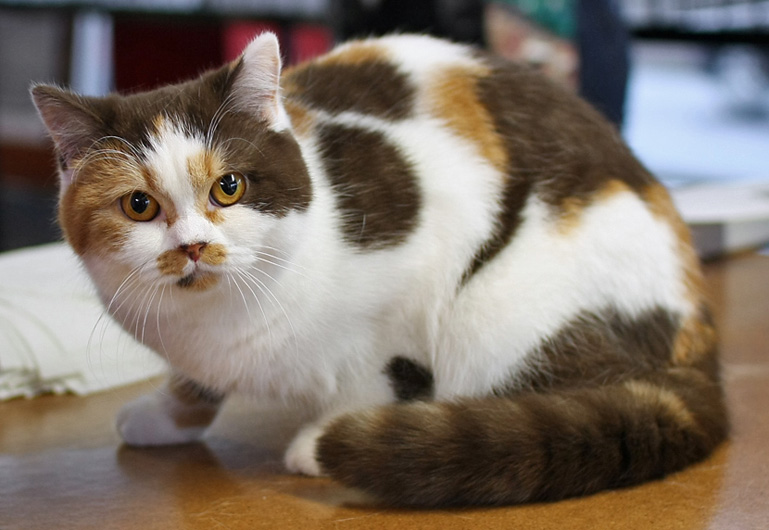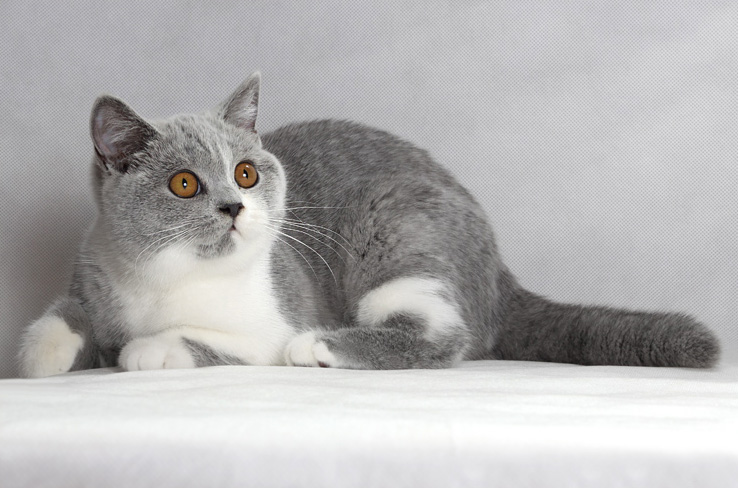Each standard of the breed provides not only the size, shape and location of this or that part of the body, but also the color. In some breeds, color does not play almost no role (for example, in sphinxes). In others, on the contrary, more than 30% of the 100 points of the standard (for example, the cortex, the Abyssinian, the Bengal and some other cats) are color-coded.
Under the color should be understood as a combination of such characteristics as the color of the wool, the pattern on the wool and the color of the eyes. In this case, the color of the coat is genetically related to the color of the pads of the paws and the lobe of the nose. And, if, for example, a purely pink cat has a pinkish spot on the cushion of the paw, it means that it is not blue, but blue-cream.
So, the colors of the British Shorthair. First, we give a description of the color of the wool according to the standard:
"Each hair should be painted from the tip to the root in the same color, excluding tabby and silvervaryette."
I believe that getting acquainted with such a description of the color of the wool will upset many owners of monotonously colored britons (monophonic color of wool is often called solid). In accordance with the above description, the blue British wool SHOULD NOT be silvered, however attractive it might look. Black and chocolate british cats the lower part of the wool should NOT be clarified. All these defects are related to marriage by color. And for the color of the wool CFA - the standard allocates 15 points, and FIFE and WCF - standards of 25 points. The American (CFA) standard clearly explains:
"The residual pattern for monophonic, smoky, shaded, shaded-gold, in bi-color or calico colors is a drawback."
It should be noted that smoky, shaded and chinchillas combine into one common group of silvery colors. The most popular among cat lovers are blue British, the second place is occupied by purple cats, the third - silver tabby and, finally, the fourth - spotted varieties. In some countries, the color of brown-spotted (chocolate stains on a light background) is not less popular.
Both European standards adhere to the following color coding.
|
Monochrome colors
And there are only seven. Black, blue, chocolate, lilac, red, cream and white - they are divided by the color of the eyes. The color should be uniform, without stains, shades and white hairs. Not allowed is the presence of any figure. The coat is thick, short and soft to the touch (plush). And, perhaps, only their encodings are worth remembering. Everything else will be remembered by itself. So:
- Black (Black) BRI n
- Blue (Blue) BRI a
- Chocolate BRI b
- Purple (Lilac) BRI c
- Red (Red) BRI d
- Cream BRI e
- White (White) BRI w
|
White color stands a little apart, since white british cats have the right to be with orange or blue eyes and even with a different eye color in one animal! The coding of the eye color is produced by a number, namely:
- 61 - blue (blue) eyes,
- 62 - orange eyes,
- 63 - odd-eyed
White British are unusually beautiful: their short, thick and soft coat is snow-white, without a shade of yellow. Any shades and spots are excluded. It is no accident that in recent years the popularity of these animals has started to increase. However, when they breed, breeders face considerable difficulties.
At the Felinological Congress held in 1997, even a decision was made to prohibit the breeding of white cats in connection with the high probability of occurrence in the offspring of such physical defects as lack of hearing, smell, etc. In addition, it is not always possible to obtain offspring from flawlessly white hair and blue eyes.
In newborn white kittens, there may be subtle markings on the head. If the animals were removed from the blue british, the marks are painted pale blue, in the offspring of black cats - in black. Therefore, it is often said that the white British "origins are written on the forehead." Since in adult animals the marks disappear without a trace, their presence in kittens is completely permissible.
Tortie colors
Tortoise - fairly evenly distributed throughout the body spots of two colors (black / red, blue / cream, etc.). Tortoiseshell color is exclusive to cats (genetics practically excludes tortoiseshell color in seals). Here are four more colors whose encoding is worth remembering:
Tortie (tortie) BRI f, g, h, j
|
The coat of "turtles" is short, thick and soft. Colors in color should be evenly mixed. The presence of short strips, in particular, on the nose, as well as cream "slippers" on the paws. According to the American standard, the stains should be painted in different colors. The nose and pads of these cats are pink and / or black, the eyes are golden or brass.
Attitude to tortoiseshells is very ambiguous. There are people who do not accept such "creativity" at all. There are others who consider this color "cool". In any case, the "turtle" is an indispensable "material" for breeding. They give kittens with such a variety of colors that any solid-mom can only dream of.
As for the exhibition career, the "turtles" have every right to it. And the judges treat these lovely girls very, very loyal. Every judge understands that British cats "turtles" are "chickens bearing golden eggs". It is in the sense of beautiful and elegant children.
Typical colors
This part is devoted to colors with "silver". This very "silver" adds the letter "s" to the encoding. Not all hair is colored, but part of it, starting from the periphery. Depending on the ratio of the colored part and the total length of the hair, chinchillas, shaded and smoky colors are distinguished.
Smoky (SMOKE) colors
Cats of smoky colors, genetically ascend to silvery. Their feature is that each wool is dyed in the main color by 1/3 of the length of the hair, the lower part of the hair and the undercoat should be of pure silver (almost white) color.
The coat is short, thick and hard. The nose and pads of the paws are the same color as the wool. The eyes of smoky British cats should be golden or brass. 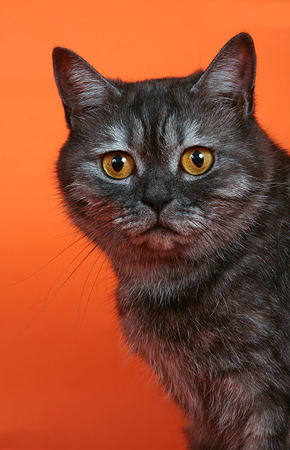
BRI ns, as, bs, cs, ds, es.
- ns - (Black-smoke) black-smoky
- as - (Blue-smoke) blue smoky
- bs - (Chocolate-smoke) chocolate smoky
- cs - (Lilac-smoke) purple smoky
- ds - (Red-smoke) red smoky
- es - (Cream-smoke) creamy smoky
When looking at a smoky cat, one gets the impression that its color is absolutely homogeneous. But, as soon as the cat starts to move, a light silver undercoat becomes noticeable. So the first impression, as they say, is deceptive.
BRI fs, gs, hs, js.
- fs - black tortie, smoky
- gs - blue-cream, smoky
- hs - chocolate-cream, smoky
- js - lilac-cream, smoky
For an example, look at a photograph of a black and smoky cat. Please note that it is highly professional to make a photo of any "smoky" cat. Apparently, it is for this reason to find good photographs of "smoke" is not so simple.
Shaded and chinchilla colors
The following group of silvery colors: shaded and "Chinchilla" (shell).
If the "smoky" colors look bright, then the shaded and chinchilla are almost white, with a characteristic "spraying" at the very tips of the wool. In cats with a shaded color, this "sputtering" takes only a sixth of the hair, and in individuals with chinchillas, and even less - the eighth. Naturally, no one measures the length of the hair with a ruler, and even more so, 1/6 or 1/8 of its color. And all the same, we call all these elegant pussies chinchillas. It is necessary to note the following points concerning the colors shaded and shell.
1. Both colors are coded as "smoky" colors, but with the figures 11 - shaded (shaded) and 12 - shell. For example, BRI ns11 - black, shaded. Externally, it looks white, with a black "sputtering," and the cushions of its paws, the outline of the nose and eye lines should be absolutely black.
2. Both colors mean that neither on the extremities, nor on the tail, nor on the chest should there be closed bands (on the chest such strips are called a necklace). In cats with shaded color, the coat should be glossed over the head, ears, sides, back and tail.
3. Chinchillas should be with bright green eyes. Shaded, that is, a little darker, have the right to be with yellow (or orange) eyes. Only to the color coding then the eye color coding is added: 62, for example, BRI ns11 62.
|
No less interesting are the golden colors (encoded by the letter y, which is placed by analogy with the letter s in the designation of "silver"). However, this is still a rare rarity for the British breed.
The chin, abdomen and lower part of the tail should be painted in a pale apricot color, the nose - in a brick, while the transition to a black or dark brown color is quite acceptable. Paw pads of the animals under consideration are black or dark brown, the eyes are green.
British cats with chinchilla color look surprisingly rich and elegant. Their fur is like a fox fur coat. Chinchilla was bred in the early 1970s. English breeder Norman Winder, who crossed the Persian chinchilla with the British shorthair. The breeder was attracted by the luxurious silvery wool of the chinchilla and the power of the British. The experiment was a success: in 1973, Winder demonstrated at the exhibition a new breed, which was called the British black with tipping ("spraying").
This color was recognized in 1980 in England by the board of the club of cat lovers.
Figured colors
In this picture, the color is called the unifying word "tabby" or "tabby", which is more correct (English "tabby"). Tabbi colors more than others remind of wild cats. The color of the coat can be any
For the British breed, the standard is three types of pattern: tiger (mackerel), spotted and marble. So simple? But any such drawing can be on the "basic" color, on a silver or gold background. Here and try, describe them all, if only the "basic" colors of 6 pieces. And also turtles, and "silver" and many - many others. So now we will not focus on the color of the picture and the color of the base.
The encoding of the picture is denoted by the numbers:
- 22 – Marble
- 23 – Mackerel
- 24 – Spotted
When assessing the exterior color of the coat is not in the first place. The head of the British cat (30), the color of the wool (25), the physique (20 points) are estimated as the most points. A separate line in the standard is the description of the eyes. Especially strictly their color is evaluated with a blue color. It should be very intense, bright copper or orange.
● Marble (classic tabby) - characterized by a dense, clear pattern with wide lines. On the shoulder blades the pattern resembles the butterfly's wings, wide, dark stripes run along the back from the withers to the tail, on the sides of the curls, the tail is girded with 2-3 wide rings. On the neck there are several closed rings ("necklaces"), which should be as large as possible.
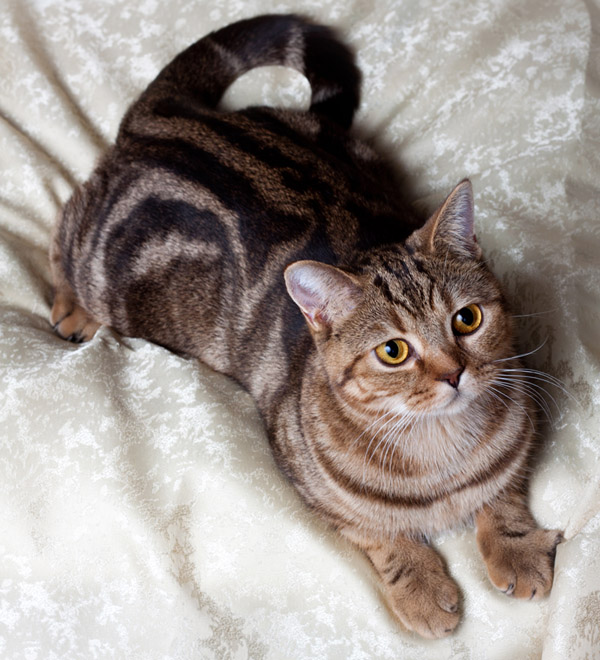
● Tiger (mackerel) - along the center of the back, a "longitudinal" line is drawn, from which perpendicularly on the sides a lot of thin transverse bands descend. The tail is also striped. "Necklaces" on the neck are like chains.
● Spot tabby - the body in separate spots, evenly scattered on the back and sides.
For a spotted tabby, frequent and dark spots are characteristic, which should be clearly visible on a lighter background. In their shape, they can be rounded, oblong or similar to a rosette. The head of the spotted tabby is painted in the same way as in the classical tabby. The limbs are also spotty. On the tail of the spots may not be, but still their presence is desirable. In addition, the tail is sometimes decorated with open rings.
The most common are silvery with black, brown with black and red with a brick spotted tabby. The standard also allows the presence of spotting in cats with even colors: black, blue, brown, red. Their eyes are of a dark orange or copper color.
Have silver tabby with a pattern the main color of the coat is pale with an obvious silvery tinge. The figure is clear, black, with separate areas, painted in red or its soft shades, is located on the body and limbs. It can be classic, tiger or spotty. The nose for cats of this color is brick, the paw pads are black and / or brick, the eyes are diamond-green or nut brown.
Main color red tabby, of course, red. The picture is clear, saturated red. The nose and the pads are brick. Eyes are golden or copper.
Main color brown tabby with a pattern (variety: classic, brindle, spotted) - shiny copper-brown. A feature of the black pattern are spots or stains of red or soft shades of this color, which can be located on the body and limbs. The nose of such animals is brick-colored, the paw pads are black and / or brick, the eyes are golden or brass.
Have blue tabby basic color, including jaws - pale blue or ivory; a deep blue image contrasting with the main one. The nose and paw pads are dark pink. Eyes are golden or copper.
Blue tabby with a pattern (classic, brindle, spotted) differs from the previous species by the presence on the body and limbs of cream stains or divorces. The nose and paw pads in cats of this color are pink. Eyes are golden or copper.
Have cream tabby The main color, including the jaws, is a very pale cream. The pattern is beige or cream, much darker than the primary color, contrasting. The nose and paw pads are pink. Eyes are golden or copper.
Have tabby with white the main color is red, cream, blue silver or brown. According to the requirements of the standard, pure white, without admixture of other colors, the cat should have a muzzle, "slippers" on the legs, hips and the lower part of the trunk. Particular importance is also attached to the symmetry of the figure. The nose, the paws of the paws and the eyes are the base tabby color.
A large selection of colors in combination with silver and gold or without it, plus three types of drawing - is this not the soil and incentive for the breeder's work?
Color-Point colors
K olor-points are characterized by the presence of darker marks (points), contrasting with the clarified body. Points capture the muzzle, ears, tail, limbs. The color of the points corresponds to one of the main groups of colors. The color of the case is very light, has a shade, a harmonious color of the points. Let's recall the main colors of the British.
- n - black (black)
- a - blue
- b - chocolate
- c - purple (lilac)
- d - red (red)
- e is a cream
The number that encodes the Siamese color is 33. If the smears are black, then this color is called seal-pont. And the encoding of this color is n33. But with the following "points" everything is simpler: blue point, a33, chocolate-point, b33, lilac-point, c33, red-point , d33) and cream point (cream-point, e33).
Color-point tabby (patterned) colors according to the drawing are not shared. That is, there can not be a color-point-marble or colorpoint-brindle. All painted color-point colors are called link-point (Links-point) and denote a combination of two numbers 21 33. But what a beauty these British!
The beautiful color of the eyes is the dream of any British colorpoint breeder.
Bicolor colors
B -color colors - a combination of any basic color with white. In addition, with white can be tortoiseshell and patterned colors. There are three main groups. Van - painted only the tail and two spots on the head. Harlequin - colored about 1/5 of the total surface of the body, some large spots are located on the back, head and croup. Bicolor - colored about 1/2 of the entire surface of the body. On the muzzle a white spot in the form of an inverted "V", on the neck a white closed "collar".
The more white, the smaller the color coding index:
- 01 - "Van" (Van)
- 02 - Harlequin
- 03 - "Bi-color"
If the second color (except for white) is black, then the color is called Black Van / Harlequin / Bicolor. And so on, white with all the other colors.
Bicolour cats should have white muzzle, chest, lower body, hips and "slippers". Ideally, the muzzle should be dyed symmetrically, as if in a kerchief. At the same time, a small asymmetry not only does not spoil the appearance of two-colored animals, but, on the contrary, gives them some piquancy. For Harlequins and Vans, a white "collar" is a mandatory requirement. In the bicolor it may not be.
|
All three varieties of bicolors (Van, Harlequin and Bi-color) can be white not only in combination with the basic and tortoiseshell colors, but also with tabby, shaded, etc. The eyes of bicolors are golden or copper.
When we are going to breed British cats, we should pay special attention to the fact that this breed has certain peculiarities. For example, a British cat will differ from the rest of the individuals with its particular exterior, as well as some habits and rules of feeding.
Exterior of a British cat
To begin with it is worth noting that the British cat is strong and muscular. This breed is significantly different from ordinary cats, since the cat of this breed stands out with really strong muscles and a well developed body. True, do not think that a British cat is a typical climber, because because of its size, this animal is more suitable for a cuddly animal, since a British cat is used to walking on the bottom, rather than jumping on furniture.
The color of the eyes of British cats may be different, while the eyes of this breed are distinctive in themselves, because it is often on them that it is customary to determine the breed.
The eyes of a British cat are usually round and very large, unlike other similar breeds. The British cat also has full cheeks, round muzzle and broad chest.
The neck of the British is very short, and the head is round. The wool is quite dense because of the thick undercoat, however, it is unlikely to call this long-haired individual.
Eyes of a British cat
If we talk directly about the color of the eyes of a British cat, then everything depends on its coloring. The most common cats of the British breed are those that differ in the presence of white color. It is these individuals whose eyes are usually surprisingly clean, blue in color. In principle, a British cat with blue eyes can be of grayish color, moreover, it is this color of cats that is the most common and habitual.
Much here depends directly on the subspecies of the British cat, but the color and blue color of the eyes can be perfect for any subspecies of the cat, regardless of the mass and shape of the ears, and also the size of the animal. Sometimes you can meet a British cat with different eyes, when one eye, for example, will be blue, and the second - orange or yellow.
By the way, the presence of orange or yellow eyes in a British cat is quite common, which can often be found in typical British Folds.
Sometimes there are British cats and with green eyes, as well as with all shades of yellow and orange, it all depends on the exterior of the cat.
Currently, the British have about 60 colors.
These are monochrome, bicolor, tricolor variants. Let's analyze more popular colors:
Blue color - Classic for the British. The coat is of an even color, from light blue to a rich blue hue. The hairs are painted from the base to the tips, carp, stains, admixture in the color are rejected. Eyes of orange, amber, copper color.
Black color should be continuous, a wool cover with a glossy sheen, hairs evenly colored, saturated black, without the slightest glint of red or red. Copper-colored eyes.
Chocolate color - new, while very rare, as there is only in those animals that have ancestors in their family tree color-point. Coat should be smooth, saturated dark chocolate color, markings, carp, strips are rejected.
Purple color - Coat of smooth lilac-gray with a pinkish tinge. Eyes of amber, orange, copper color.
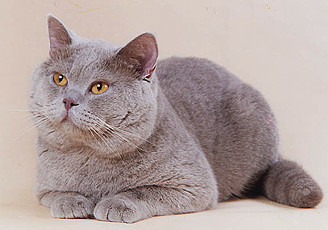
Cinnamon color. Lighter than chocolate and has a warmer tone. In this case, the nose of the nose is painted in a pinkish-brown (almost beige) color, as well as paw pads. Adult cinnamon-colored cats acquire a warmer tone with a reddish-brown luster, while the undercoat at the base is always slightly lighter than the base coat and this is not considered a deficiency in cinnamon. In the color of cinnamon: the color of the coat is red-brown (cinnamon), the undercoat is yellow-brown, lighter than the main tone, and the red tone of the coat is light copper sometimes bronze (in bicolors), and not orange as red ones and never brick gray . Kittens pads paws, nose mirrors and lines of lips and eyes are very light almost white with a slightly pinkish tinge, and in adult animals - the color of cocoa with milk, under stress darken to the color of milk chocolate. In breeding it is difficult to obtain this color, knowledge of genetics is required.
Faun color. In the faun, the color is light beige, sandy sometimes called - Oleny (fawn-English. Nose mirror, paw pads and strokes for the fawn color, pink-beige, very delicate tone. Also, like cinnamon is quite difficult to breed, so it is very popular and in demand.
Cream color. Coat should be of uniform light cream color, preferably without leopard marks. Such marks are most often more noticeable during the hot season and during moulting. Eyes of amber, orange, copper color.
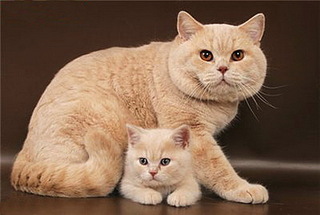
White color. British shorthair cats of white have three varieties: with orange and blue eyes, disagreements. Buying a white kitten, you need to keep in mind that up to 12-18 months the color is not yet fully formed. White kittens with blue ancestors in the family tree will have pale blue marks on their heads, and those who have ancestors of black color will mark the marks black. With age, the wool becomes pure white. The hairs should be exactly painted, clean, shiny white, without yellowness. The eyes are dark orange, copper, in disagreements - one eye is orange, the other - blue. White cats with blue eyes can be deaf.
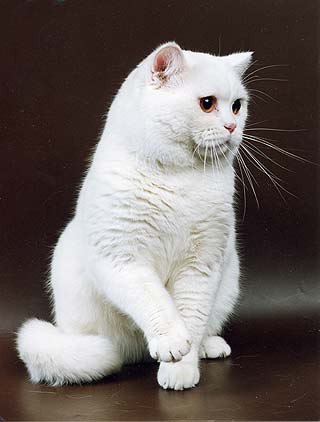
Blue-cream. The coat should be evenly mixed blue and cream colored. Is not a marriage narrow strip on the nose and cream marks on the paws. Eyes are dark orange, copper. According to the standards adopted in the United States, cats of bluish-cream color should have a wool cover, stained with blue and cream colored stains.
Color Point. Extremely rare color, obtained on the basis of the British, having in the pedigree long-haired color-points. The coat is colored like that of Siamese cats: paws, tail, mask and ears of dark color, the trunk of contrasting light color. Eyes are bright blue.
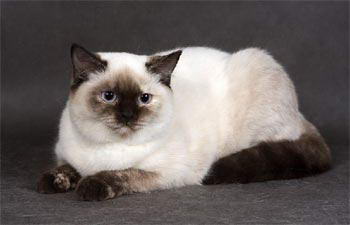
Smoky color. Very beautiful color, with the integumentary hair of a homogeneous bluish-gray color, and the roots of the hairs are silvery. The wool of such cats is very thick and stiffer than in cats of other colors. The eyes are dark amber, brass.
Black smoke. Undercoat should be white, and the ends of the wool form a strong black color. When looking at the back and sides of a motionless cat, it seems that it is black, a white undercoat is visible when moving. Below the sides, the coat has a silver undercoat. According to the standards of Great Britain, on the paws and the muzzle, the wool must be black along the entire length, and according to the standards of the USA - at the roots they must be white. Eyes bright copper, orange.
Blue smoke. The coat is such that the hairs are painted at the base in white, and at the ends - blue, which creates an impression of a monotonous blue color on the back and sides of a motionless cat. On the paws and muzzle, the wool should be painted blue throughout the entire length according to the standards of the United Kingdom, according to US standards - at the base should be white. Eyes orange, copper. Now quite a rare color.
Tabby (link, marble, mackerel).
tiger (mackerel, mackerel)
spotted
marble (blotched, blotched)
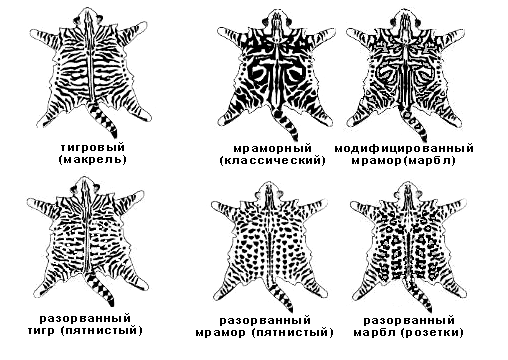
Color can be of three types: classic, spotted
and striped.
The classic pattern is a butterfly-shaped mark on the nape and shoulders, rounded marks on the sides.
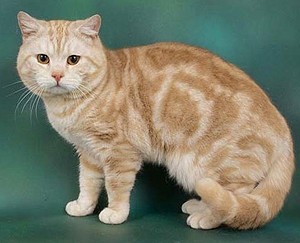
In the striped pattern, there are vertical strips on the trunk, it is more commonly called the tiger tabby.
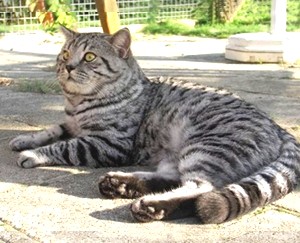
All tabby colors on the forehead of the animal should have a mark in the shape of the letter M.
The eyes are dark orange, copper, the silver tabby has green, yellow-green.
Spotted color in which dark spots are scattered on a lighter background. On the tail on a light background - dark rings, on the forehead - a mark in the form of the letter M.
Usually spotted cats come with black, blue, brown, red spots on a silvery background. Eyes are dark orange, copper.
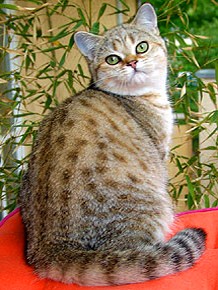
Tortie color. It occurs only in female cats. The coat is colored with spots of different colors with clearly defined boundaries. Do not reject the narrow strip on the nose and cream spots on the soles of the feet. Eyes are dark orange, copper.
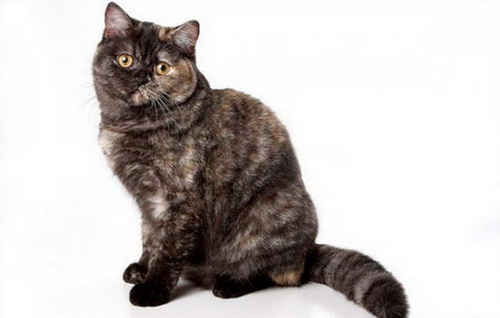
Red color.Obtained by introducing into the genetic line of British Persian and exotic cats of red color. The coat is of a level fire-orange color, it is usually called red, but in genetics the correct name is red. More common are tabby markings, less often clean. The weaker the stripes are expressed, the better. Eyes are dark orange, copper.
Colors with white spotting (bicolor, harlequin, van, tricolor-calico, mitted) The colors of cats with a white spot are very elegant and original. They are different combinations of the basic color with varying degrees of white predominance and are combined into a common group of particolors. At the same time there is a separation according to the color of the color spots - they can be either monophonic (for example, black, chocolate, lilac, cinnamon) - then it's bicolors, or carry some drawing - then it's actually particolors.
Color bicolor. In these cats, the coat has clearly delineated areas of white and any other color found in Scots. White color should occupy from 1/3 to 1/2 part of the total surface of the body. The eyes are dark amber, brass.
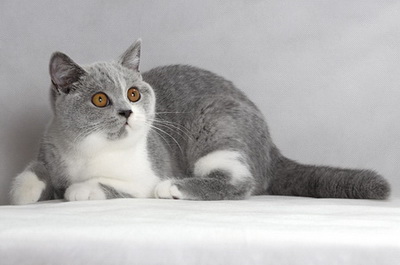
Color Van. This color is characterized by the maximum amount of white in color. On the head of the cat color cats should be present two spots, separated by a white line, and the ears should remain white. The tail should be painted completely, and on the body of the animal one or two minor color spots are allowed. But their complete absence is desirable.
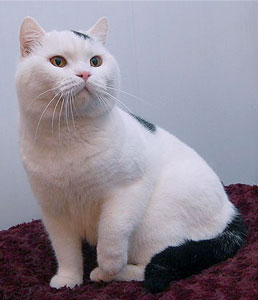
Color harlequin.This color is intermediate between the bicolor and the color of the van. Colored spots make up no more than 1/6 of the part and are placed in a certain way. On the head, on the back and front paws, colored hind legs and colored tail. On the head sufficient is the presence of only one spot that covers the ear of the animal. There are several spots on the back. The tail should be painted completely. The presence of small spots on the paws is not a defect, but, ideally, the breast, neck and legs should be pure white, and the tail is completely colored.
Color Calico (tortoiseshell with white). It is a tortoiseshell with white color, which happens only in female cats. The coat is colored with spots of black, red and cream colors in combination with white spots. British and European standards require that the painted areas are evenly interspersed with white, according to American standardsthere - white color is desirable on the lower parts of the trunk.
There is a clarified calico, in which the wool cover is characterized by a combination of blue, cream and white colors. Eyes are dark orange, copper.
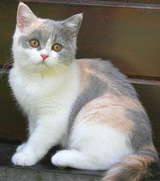
There is still the color of Mitted, this -the white color covers no more than 1/4 of the case.
As a rule, this is a white band that stretches from the chin to the chest, the groin, the belly of the animal and the "socks" on the legs. This color is not recognized by the felinological organizations and is considered a disadvantage.
Cameo with tan marks. In this color, the undercoat should be pure white, and the color of the undercoat should be a saturated red color. The eyes are bright copper.
Silver with tan marks (ticked, chinchilla).Another name for this color is shaded. A relatively new color recently withdrawn. Relatively recently, a special standard was set for them in the United States. It exists in several variants: silvery, cameo and tortoiseshell (it occurs less often, since it is not so popular among breeders). The coat is 1/4 part of the length of the coarse hair is colored in the main color, and on 3/4 - white. In silvery with tan marks the undercoat should be pure white, and the crayfish black. Eyes green, bluish-green.
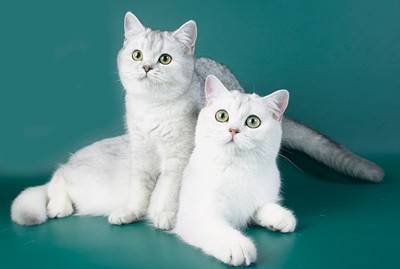
Gold ticked, shaded.
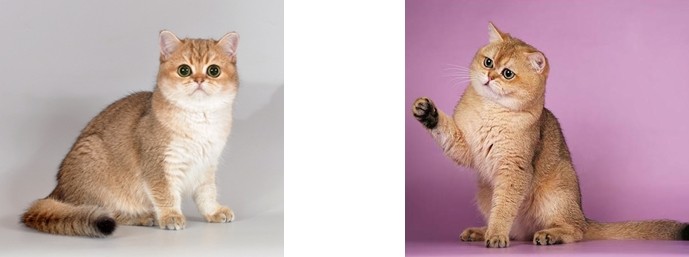
British plush cats - the pride of Britain - have been conquering the hearts of cat lovers for many years. Their popularity is growing day by day. truly English: they are characterized by aristocratism, intelligence and self-sufficiency.
Many imagine the British only one - the blue color. However, like the Scottish, British cat colors (see photo below) can have a wide variety. For today more than 250 varieties of colors are known, and this is not the limit. Rare combinations of shades are highly appreciated by both professional felinologists and among ordinary rock lovers. Even a cat of a classic monophonic color can have a kitten of a rare color. To order the variety of colors of British cats, they are divided into types and groups according to the main color, pattern and the type of pigmentation.
Cats are from the end of the 19th century. Since that time, serious work of breeders on the breeding of animals of different colors and breed varieties begins. So, initially these cats had a short thick wool with the same thick undercoat, but crossing with the Persians made it possible to withdraw semi-long-haired pets. Colors of British cats with long hair correspond to the color of short-haired. In spite of this, the British refer to natural breeds, which were not too subjected to changes in the type.
If you want to know in more detail what the color of British cats can be, the photo and description will help with this.
Colors of British cats: table with photo
| #
| Color code (BRI) | Color code (BRI) |
|---|---|---|
 | W - numbers from 61 to 64 |
|
 | Plain (even, solid) | |
 | Tortoiseshell (tortilla) | |
 | Smoky (smokey) | NS / AS / BS / CS / DS / ES - numbers 22.23.24; FS / GS / HS / JS - numbers 11, 12 |
 | Shaded silver color | NS / AS / BS / CS / DS / ES - numbers 11.12; FS / GS / HS / JS - numbers 11 and 12 |
 | Golden shaded | NY 11.12 |
 | Figured (tabby) | N / A / B / C / D / E - numbers 22.23.24; F / G / H / J - numbers 22, 23, 24 |
 | Silvery patterned | NS / AS / BS / CS / DS / ES - numbers 22.23.24; FS / GS / HS / JS - numbers 22.23.24 |
 | Golden patterned color | NY - numbers 22,23,24 |
 | Bicolor, color and harlequin | N / A / B / C / D / E - numbers 01.02.03; F / G / H / J - numbers 01,02,03 |
 | Colorpoint | N / A / B / C / D / E - No. 33; F / G / H / J - number 33 |
 | Colorpoint with a picture | N / A / B / C / D / E - Nos. 21 and 33; F / G / H / J is also number 21 and 33 |
Monochrome colors
The uniform color of British cats is uniform, without spots, patterns and any white wool. The appearance and touch of the coat is plush, thick and soft.The following single-color colors stand out:
Blue, or gray color
Classic and most common. It is this color that comes to mind when it comes to British cats. Wool with this color should be monophonic, while the undercoat may be slightly lighter than the base color, but whitish wool is inadmissible. Especially valuable is the lighter blue color. Kittens are allowed to have strips that eventually disappear. The color of the iris in British babies is gray or blue, but with age it becomes saturated with amber color.Black color
This is a rare color, it is complex in obtaining and refers to "moody". It often happens that a kitten, born black, changes the color of the coat to chocolate as it ages. Pigmentation of wool, undercoat and skin saturated. In this case, the color of the undercoat and wool should not be different. It is believed that the more uncolored colors of ancestors on the pedigree, the more saturated will turn black. Here, the rule of knitting is the same with a similar one, without experiments, so as not to harm the breed.
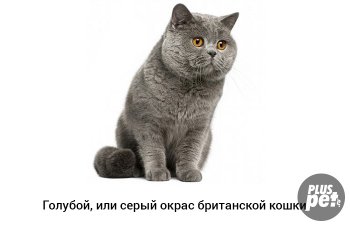
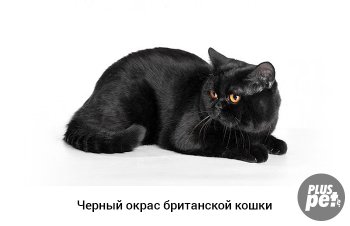
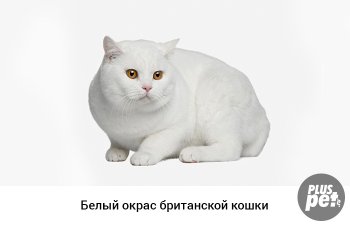
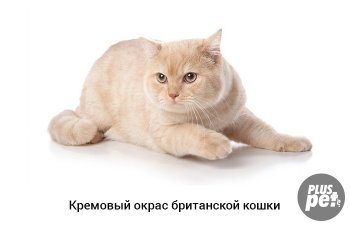
White color
The white color of the fur of a British cat should be clean, without yellowness and blemishes. Kittens are allowed blue or black stripes on the forehead, but with age they disappear. The color coding of the eyes is denoted by a number, so 61 are blue (or) blue eyes, 62 are orange, 63 are odd-eyed, 64? green. Interestingly, the name itself is "white"? this is not a color, but its absence, so in a group of monochrome colors, white color stands apart. Animals with ideally white hair are difficult to breed, and the production of such color is associated with a high risk of unhealthy offspring. So, the parents of white have a high probability of the appearance of offspring with deafness. Since 1997, breeding work with white color has been discontinued.Cream color of British cats
It is a clarified red that is obtained by the presence of a clarifying gene. This shade of wool refers to the oldest types of monochrome colors, but recently it has become rare in breeding. The british cream color should have a clean (pastel shades) hue, intense color, and color ie. "Hot" cream is considered a disadvantage. Kittens have a tabby pattern, and for adult animals, residual tabby marks are acceptable. The nose and paws are pink. The quality of wool cream British are not inferior to blue and purple.Chocolate color
Must be saturated and deep? the darker the shade, the better. This color is called in another way havana, or chestnut.
Recently, breeders as a result of careful selection of offspring, i.e. future manufacturers, have achieved high quality wool, in no way inferior to the classic blue. The wool of such cats looks like a mouton. For the British, the standard recognizes all the chocolate shades: from light dairy to dark "bitter." The color of the eyes of the British chocolate color is dark orange or copper, and the saturated colors in priority. The nose of the nose should be in the tone of the wool: chocolate or light chocolate.

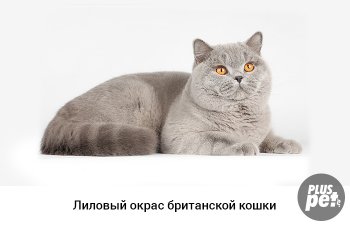
Purple color
Purple color of the fur of a British cat? this combination of gray, pink and blue colors and it looks like a clarified chocolate. The nose of the animal, like the paw pads, corresponds to the tone of the coat. Eyes of orange-copper shades. Purple color is represented in various variations: from cold lavender, to warm pink-gray. The undercoat of cats of this color in tone can be slightly lighter than the cover hair, however the expressed contrast is not permissible. Kittens often have a residual pattern (moire), which disappears with age. In quality, the fur of purple Brits resembles a blue mink fur coat, to the color of which is mixed a little pink paint. The nose, the pads of the paws and the edging of the mucous pink-lilac shade, which darkens with age.Red (red, gold)
Red British color was introduced from Persian and other exotic breeds of cats that have a red hue of wool. Such cats on the forehead often have tabby marks. The eyes of British cats with a red color of wool have a rich orange color. Nose color, paw pads red, brick. A significant drawback of the red shade of wool in Britons is the uneven color distribution, so, the cat's tail often has a clarified tip, so it's quite hard to meet a Briton with a homogeneous red color. In view of this, the standards allow a small slightly outlined tabby pattern.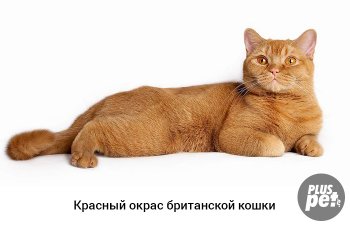
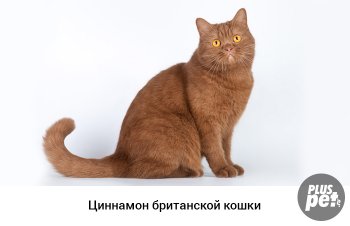
Cinnamon
A rare, very desirable color, whose name translates from English as cinnamon. The shade is similar to the clarified chocolate color. Cats of the color cinnamon are born quite rarely, because the gene of this coat color is recessive. Cinnamon British always have pink cushions of paws and nose, but brown or dairy? no longer cinnamon.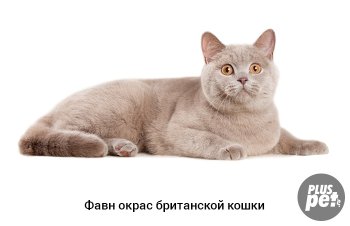 Faun
Faun
No less rare and desirable color for breeders. It looks like a clarified, burnt cinnamon. As an independent color, he was recognized in 2006.
Color is very interesting for breeders because of the possibility of bringing out even more clarified colors. The affiliation of the cat to the faun is confirmed by a DNA test. Individuals with a similar but unconfirmed color are referred to as blue, cream or discarded.
Tortie colors
A tortoise variety of color? This combination of spots of solid color, leaving on the cat's fur a mosaic pattern in various combinations. Intensive solid colors? black, chocolate and cinnamon? combined with red, in turn diluted options: purple, faun and blue? with cream. This type of coat color is characteristic only for cats.Tortoise coat color shows up gradually. A newborn kitten may have few spots, but as they grow, their number will increase. Young British cats can have a gray undercoat or a slightly muted red shade, but the color is finally formed by the year.
Cats tortoiseshells are rightfully considered the queen of any nursery, tk. they can give offspring, varied in color.
Variants of tortoiseshell colors of British cats:
Black turtle
This is a harmonious combination of proportional red and black spots of different shades. The hairs are evenly colored. Black color should be saturated, and red, respectively, bright and intense. On the paws and head tortoiseshell british must be present both shades. According to the standard mixed blobs are permissible. It would be desirable to have a red "tongue of flame" (scorching) on the face. It is not advisable to have drawings on spots of red color.Chocolate turtle
It is a combination of chocolate and red shades in identical proportions of a mosaic. General requirements, as in the previous case: intense, saturated color, harmonious arrangement, evenly colored hairs, scorching on the muzzle and lack of pattern.
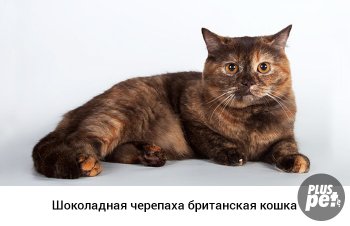

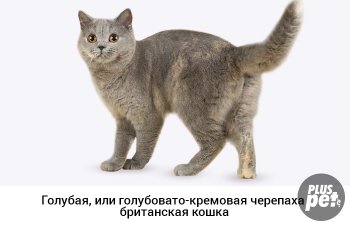
Cinnamon Turtle
This is a combination of cinnamon-colored spots and red shades on the coat. The requirements for color are the same as for black and chocolate turtles.Blue, or bluish-cream tortie
Combines a blue and cream mottled pattern, specks should also be proportional. The tone of this color can be either light cream or medium blue. On a muzzle in such type of color the cream scorch is welcomed.Lilac (option: lilac-cream) turtle
This is a uniform combination of respectively lilac and cream shades. The colors should be clear. It is desirable to scorch in cream color, going to the nose.Faun turtle
The combination of the color of fawn wool and cream stains. The basic requirements are the same as for other tortoiseshells of the British.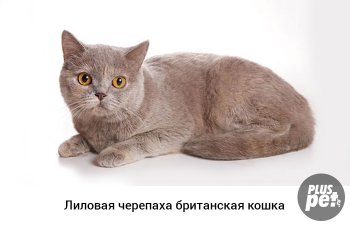
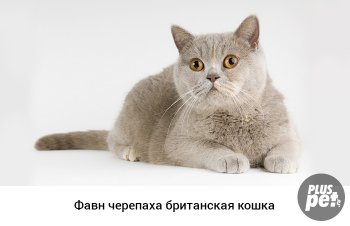
Tabby Colors
Colors tabby are a brindle, marble, as well as a spotted pattern on wool type agouti. Also, color tabby implies the presence of the following important elements:- Ticking? the presence of zone-colored hair that make up the background, and the hairs of the pattern are almost colorless to the very bottom.
- The so-called "scarab sign"? pattern on the forehead in the form of the letter "M".
- Presence of a light spot resembling a fingerprint on the auricle.
- Strokes of the eye mucosa and nasal mirror in the main color.
- Necklace on the chest (not less than 3 strips), curls on the cheeks and rings on the tail and paws.
- There are 2 rows of double spots on the abdomen.
- The picture is clear, saturated, not blurred, painted in any primary color or mosaic (for tortoiseshell british), contrasting to the main background, which is a few shades lighter.
Types of tabby colors
Tabby-drawing does not depend on the basic color of the wool, this is a picture of a dark color on a light background. Variations of color can be as many as there are colors in general.Not subdividing into the types of drawing, we can distinguish colors:
- brown tabby ? the main part of wool is copper-brown, and the pattern is rich black.
- blue tabby differs background light-blue shade and marks of the sated-blue color
- for chocolate tabby typical of the bronze shade of wool and a pattern of deep chocolate color.
- lilac tabbyit is characterized by a lilac pattern and a beige background tint.
- red tabby: a pattern of dark red color and an intense red tone of wool.
- cream tabby ? a pattern in rich cream shades, the color of wool is warm pale cream color.
- silver tabby-colors, or silver tabby: silver black, blue, chocolate, red, lilac-silver, cream-silver. The deep deep shade of the main tone, and the area outside the picture, has a silvery or pale-silver tinge to the main color (for example, silvery-cream or silver-blue, the letter "s" is added to the code of the figure.
Tiger (mackerel) tabby
This color is considered an ancient natural pattern, and is quite widespread among cats. Along the spine, from head to tail, a narrow solid strip in the main color is visible. And along the entire surface of the body are vertical parallel strips. The more of them, and the more they are, the better. They should be clearly separated from the main background. On the forehead, the British must have the drawing letter "M". A continuous line leads to the occiput from the outer edge of the eye. On the neck a "necklace", on the cheeks narrow stripes, on the belly of the cat double spots, similar to buttons, and on the tail and limbs uniform narrow rings. Despite the fact that this color refers to the dominant group of tabby colors, it is rare in the British breed, and the real British "cubs" are very appreciated among professional breeders.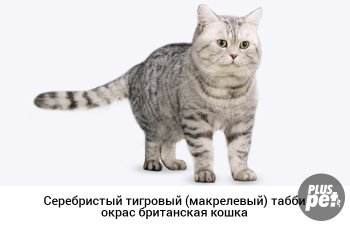
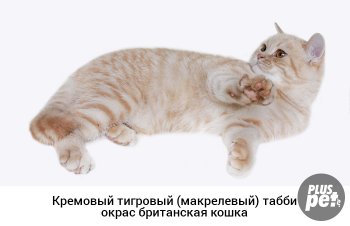
Spotted (spotted) tabby
The basis of the pattern is the tiger pattern. In spotty British under the action of polygons, strips are interrupted, forming along the whole body small round spots on the wool, which can be of different sizes, but necessarily of the same shape and evenly spaced. The scarab sign, as in the previous version, is mandatory. Down to the neck and along the back are intermittent strips. Kittens are allowed a solid strip on the back, but with a tendency to spot. On the chest, neck and tail of the cat are open and closed rings, the painted tip of the tail. On the paws can be rings and specks. On your cheeks? strips.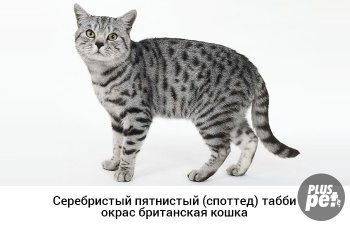
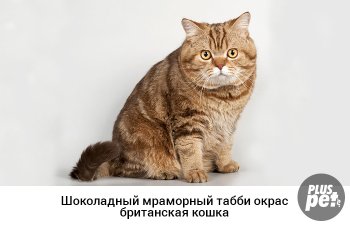
Marble tabby color
It refers to the classic, popular drawings. In fact, this is a mutation of the striped variant. The pattern resembles a cut on marble. All its elements must be contrast, symmetrical, have a rich color. On the forehead must mark "M". From the outer corners of the eyes to the nape of the neck go narrow strips, and from the back of the head begins to turn over the neck and shoulders drawing "butterfly". On the cheeks of the cat, the narrow rings are twisted into a spiral. On the back from the shoulders to the tail pass three parallel lines. On the sides are pronounced divorces, on the neck and chest "necklace". Are there buttons in the area from the chest to the stomach? two parallel rows of specks. On the paws and tail there are clear evenly spaced rings, the tail tip is dark.Torbi-color (short for tabby and tortilla)
This is when a tortoiseshell animal combines, in addition to spotted mosaic, tabby drawings that cover the entire body of a cat and have all the distinctive features. If the color is uniform, there are no stripes and characteristic signs of the tabby, then the cat has a normal tortoiseshell color. The color of the torby differs in the expressiveness, clarity of the tabby pattern, which runs evenly and appears above the tortoiseshell (both in red and black).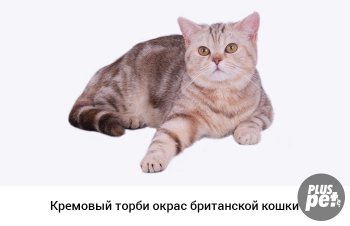
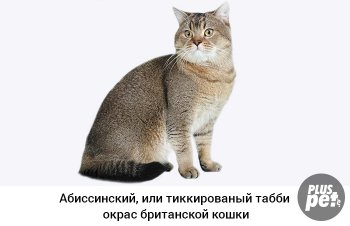
Abyssinian, or ticked tabby
Color is named after the Abyssinian breed, where it is most pronounced. With this color, the hair should be evenly colored with strips of dark basic and correspondingly light background shades. This is called a tikkig. Each wool has a double-triple ticking. Moreover, there should be no patterns, stains or drawings on the wool. Markings are allowed only on the clarified abdomen. The presence of a "necklace" on the chest should be minimal.Smoky colors
The smoky colors of the British wool are quite common and numerous. The peculiarity of this color is that, under the influence of the inhibitor gene, the outer wool is stained only from above, and the hair is deprived of the pigment from the roots and undercoat. This tanning is called tipping. In this group there are 2 subgroups: smoky type and chinchilla.Smoky should not be confused with the agouti color. Smoky type cats have a completely painted nasal mirror and should be without drawings on the body. Hair tipping is quite deep: it should be painted 4/5 of the total length. The main signs of smoky British: pronounced contrast, the undercoat is as close to white as possible, and the tips of wool are saturated color. This color of British cats does not convey the photo to the full: first it seems that the cat has a solid color, but only its beauty can be appreciated alive, as during movement the "silver" appears, which disappears under the plush coat.
Varieties of smoky color
Black smoky
Wool of contrasting shades: from smoky black to silvery on the sides. Undercoat is whitish, black patches are visible on the back and sides. The muzzle and legs are black, without patterns or marks.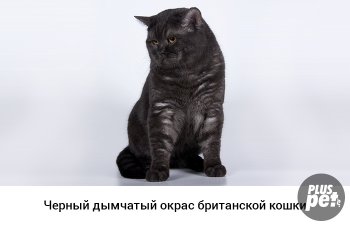
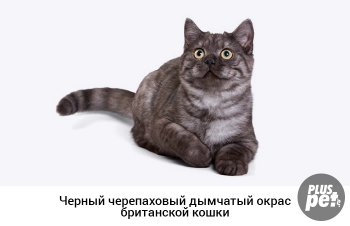
Blue Smoky
Wool of contrasting colors: from smoky-blue to silvery. Muzzle and paws of blue color, without any marks. The undercoat is closer to the white shade, and the coat on the abdomen, chin, under the tail is silvery-white. Chocolate smoky differs smoke-chocolate shade of wool, turning into silver on the sides. Wool of the chin, lower abdomen of a silver-whitish shade. Undercoat is close to white, muzzle and paws of chocolate color, without marks.Purple Smoky
The shade is lilac in contrast to the white undercoat. On the sides it turns into silvery. Chin, belly and tail of the tail are silvery-white. Muzzle and legs are lilac without marks.Red Smoky
implies a red shade of wool with a white undercoat, chin and abdomen are silvery-white. Muzzle and legs have a monochromatic red shade. Tabby on wool is not allowed.Cream-smoky
When the cream-smoky color predominates, the white contrast in the region of the sides with the transition to the stomach and the bottom of the tail. Undercoat is white. Paws of cream color, tabby-drawings are not allowed.Turtle smoky colors
Do they look like mixed shades with a combination of basic derivatives? black and red? colors. Tipping can be of any intensity. In the undercoat, white predominates. Collar, ears and sides of a silvery hue.Silvery colors: typical and shaded
These types of color develop on a genetic background agouti.Silver shaded (shading color)
For this color, hair coloring by 1/3 is characteristic. It is characterized by a white undercoat and black tipping. Required is the presence of tipping in the head and tail area. On the chin, chest, bottom of the tail and abdomen should predominate white shade. The color is uniform, which gives the impression of a dark cloak. The eyes of the cat, nose and lips must be necessarily with a black edging. Suppose an easy drawing (not closed rings) on the tail and legs. Eye color can be green or green-blue.In the silver-shaded version there are the following colors:
- silvery-blue shaded;
- silvery-purple;
- silvery red;
- silvery-cream;
- silvery chocolate;
- tortoiseshell shaded.
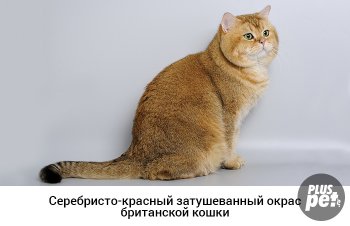
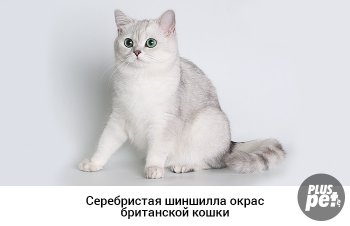
Silver chinchilla (silver veil)
Color, in which the pigment is distributed only to 1/8 of the hair from its entire length. It is characterized by the prevalence of white undercoat. On the back, tail, in the head area, on the sides and on the ears there is a black tipping. The main requirement for silver chinchillas is a uniform distribution of tipping. The areas of the chin, chest, abdomen and bottom, tail, and whiskers are white. On the lips, the nose around the eyes has a dark rim. The eyes in this color are green or bluish-green.In black, the name of the chinchilla is used, and for the remaining colors of the silver line, the main color is indicated: blue chinchilla, red chinchilla, etc. For the silvery colors of the British cats of the red line, the name "cameo" is added: a smoky cameo, a veil cameo, a shaded cameo.
Deep, pronounced tipping in silver types of color makes it possible to manifest a pattern, which causes the appearance of silver tabby with different patterns (spots, bands or marbles). So, for example, silver marble (blue, black, etc.) is a well-known so-called "whiskey" types.
Golden colors
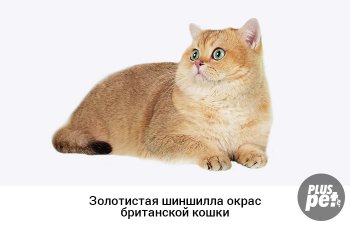 A golden series of colors of British cats is divided in the same way as silvery. This type was derived relatively recently, which explains many of the controversial issues in the classification. In the golden variation, there can be no red and cream shades of wool.
A golden series of colors of British cats is divided in the same way as silvery. This type was derived relatively recently, which explains many of the controversial issues in the classification. In the golden variation, there can be no red and cream shades of wool. The undercoat of golden cats is not white in color, as in silver ones, but in a rich creamy or apricot color. Hair has black (as an option: brown) tipping on the head, in the back, tail and sides. Cat's chin, ears, chest and belly are gentle-apricot, nose? brick, the paws are dark (from brown to black). On the tail, tipping is deeper than on other parts of the body. Eyes must be green. Mirror of nose reddish shade. Kittens are allowed tabby markings. In adult individuals? the letter "M" on the forehead, as well as closed rings on the legs and tail and an open necklace.
Color Point
The color of British cats of the color-point type differs by special color marks.Such an unusually attractive type of color the British inherited from the Siamese. Stained the most intense in remote areas of the cat's fur, but other parts it is lighter, but not pure white.
The accumulation of pigment (marks) is called "points", and the overall color in relation to the main body is called color-point. The gene of Siamese color is recessive and in order for it to manifest itself in the future, both parents must have it. Also, the gene is linked to the blue eye. It is difficult to breed the color of the British color. Kittens are born pure white or close to white, so the picture of British kittens of all colors can not be found color-point. Markings begin to stain with time.
Colored Siamese gene is combined with all the colors of the British breed. If it "works" with monotonous colors, then it is called color-point, if in combination with tabby-colors it is a point-point, and the combination of a picture on points with silver? has the name silver link-point, respectively shaded colors? this is a shaded point.
Solid color-points are characterized by the rhomboid color of the face, and the color of the marks should be identical in color with pronounced borders on the transitions. The rest of the body is painted in light colors, and the lighter the better. Mask of the face should not move to the back of the head in any way. Foot pads, nose according to the shade completely correspond to the main color of the marks.
The number of colors of color-points is the same as that of solid colors:
- force-point (marks are dark brown);
- choklit (all chocolate shades);
- blu-point (bluish markings);
- lilak-point (warm lilac shade);
- red point (warm red color of marks);
- krim-point (cream marks);
- cinnamon-point (marks of golden cinnamon color);
- faun-point (beige-sand markings).
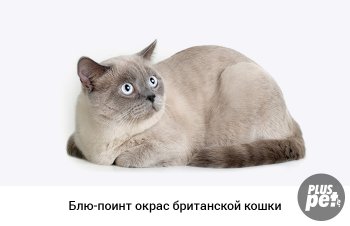
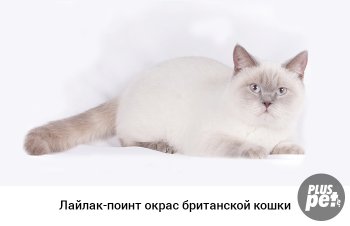
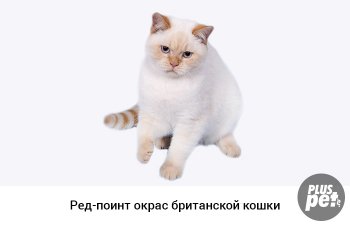
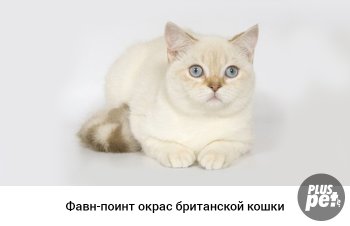
Tortie Colored Points
In such colors, in most variants, the color of the markings repeats any of the basic shades, and the specks on it are of red or cream shades. Coat color is light cream or beige. Pillows and a mirror of a nose in the basic tone of points.There are the following colors of tortoiseshell color-points:
- force-torti-point;
- blu-krim;
- chocle-tortie;
- lilak-torty;
- cinnamon-torte;
- faun-tortoise.
Tabbi Point (Lynx) colors
They are distinguished by the presence of a tabby pattern on the points: the letters "M", the drawing around the eyes, the pronounced spotting in the area of the mustache, the spots on the ears. The body of the links is very light, without any pictures. On the front legs of the cat pattern in the form of open rings, coming from the fingers up. On the hips there are strips, and on the hind legs to the hocks? solid shade. Pads of paws and the area around the nose in the tone of the marks. Link-point colors are represented in all varieties, in which only tortoiseshell and point colors can be.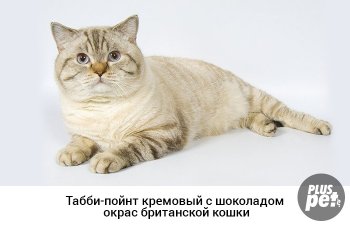
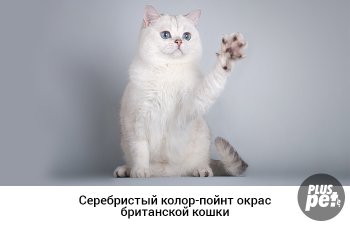
Silvery color-points
In this group of colors color-point are smok-point and sylver-tabby point. From other variations, colors have a lighter shade of the body and marks, as well as the presence of a whitish undercoat. The requirements for this line are the same as for color-points, but the contrast is not so pronounced and intense. Smoke-points (smoky) can have shadow bands, which does not apply to a defect.Shade Point and Chinchilla Point Color
It is quite difficult to distinguish the chinchilla-point from the chinchilla's color, but it is quite possible: the chinchilla point is characterized by blue or blue eyes. Also, the tone of tipping is slightly highlighted in relation to the points. To these types of colors, the requirements are the same as for the tiptrated ones. The contrast between the point marks and the rest of the body is not so important.Interestingly, golden color-points are very rare, so the description in their respect has controversial points.
Color with white color - particolors
Color particolors in the British breed are distinguished by their originality and uniqueness.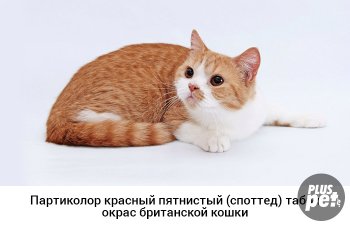
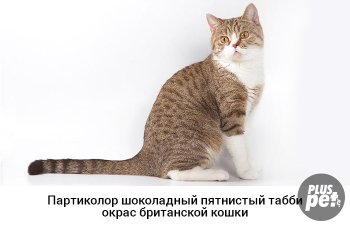
The group of particolors includes all colors and their combinations with varying degrees of white. It is necessary to distinguish particolors from bicolors: if the former have colored patches not of solid color and / or patterns, then the latter differ in monochromatic color spots. Following the standards, not less than 1/3 of the part and not more than 1/2 of the shade of white are bicolors (at least 1/3 and as much as 1/2 of the white surface) and particolors; more than 90% white? cats harlequin (about 5/6 white) and vana (the maximum amount of white).
For bicolors is ideal, when the cat's chin, chest, abdomen and inner surface of the paws are white. On the neck there should be a closed white "collar", and on the muzzle the letter "L". The top of the animal's head, shoulders, tail and so on are painted. "Cloak" on the back, which should not have whitish impregnations. Approximately such a distribution in the standards is desirable and more preferable.
In harlequinson the white back, head and hips are clearly outlined large or medium colored spots of different shapes. Ideally, the neck, chest, abdomen, paws and chin should be white. The tail is painted completely.
Color of British cats van is characterized by a large amount of white. Two spots on the cat's head are required, separated by a whitish line. In this case, the ears should be white, the tail - colored. In the color of the baths, small color spots on the body in the amount of 1-2 are permissible.
Tricolor turtle with white linked to the floor, so the tricolor can only be cats. This color has the following feature: black and red spots do not mix, as in tortoiseshell, but are isolated and delineated.
Mitted Is a color not recognized in the British breed, therefore it is considered a disadvantage. In such animals, white spotting occupies not more than 1/4 of the total surface. Also characterized by a white band across the chest from the chin, white groin and abdomen, the so-called. "Socks" on the paws.
Cat breed british white has always been very popular among fans of furry pets. Resist the beauty of an immaculate snow-white coat british cats it's simply impossible! It is an impeccably white color of wool without a single dark hue, is the main distinctive feature for cats of the British breed. Their wool has a uniform color throughout the body from the ears to the tip of the tail, without any stains of other color. Only sometimes the kittens of the British white cat can observe small spots on the forehead, which eventually disappear, leaving a white snow coat in return.
Another distinguishing feature is their large, unique eyes of orange or copper color. Very rare white british cats with blue eyes, although these cats look very beautiful, but this sign is considered a deviation from the norm, and cats with blue eyes are not used in breed breeding, but because of their rarity they are in great demand among breeders of British cats. In all newborn British white kittens, the color of eyes is gray-blue, but after two weeks it begins to change, and according to the intensity of the coloring segment, experienced breeders already at this age can determine whether the pet has yellow or blue eyes. So if you want your british white cat participated and won at the exhibitions, pay special attention to the color of the eyes when buying a kitten.
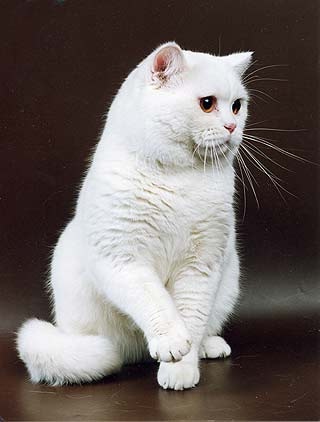
Occurs at british white cats one more anomalous phenomenon, these are eyes of different colors! Yes, yes, in the practice of breeding British cats, there were also cases when one eye of a copper-colored pet, the second - a sky blue. But to meet such a pet is a rarity, and despite the unusual appearance, cats with different eyes are in great demand, as among the breeders there is an opinion that a cat with eyes of different colors brings good luck and happiness to the house!
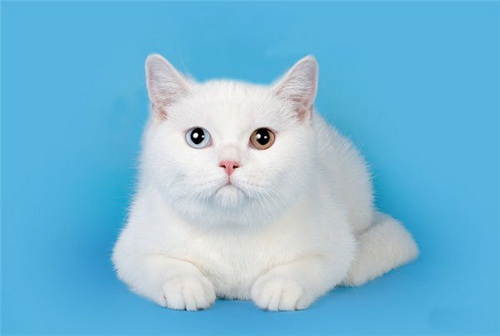
Caring for the coat british white cat quite easily, it is enough only to periodically comb out the pet to remove the fallen hairs, although the cat herself, as if understanding that her white coat should look perfect, constantly take care of her. Before the exhibition, care for the coat should be more thorough, it is possible that you will even have to bathe your pet with the use, or apply to clean his coat if your pet does not like and does not tolerate water procedures.
It is distinguished by its calm and undemanding character. These are affectionate and fairly friendly pets, but very fastidious in food, however, like all British breeds! Your white british cat very upset if he does not find in his bowl a damp, slightly scalded boiled water, diced meat. It is because of this form of pieces of meat eaten by the cat that the muscles of the cheekbones develop in her, and the muzzle acquires a roundness characteristic of all Britons.
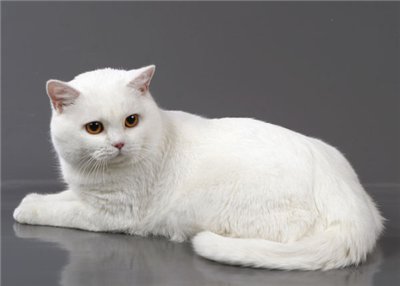
Becoming a happy owner of a white British cat, you will find an affectionate, loyal and reliable friend for many years, and the color of the pet's fur will please you with its impeccable, snow-white cleanliness!
More information about the colors of British cats

